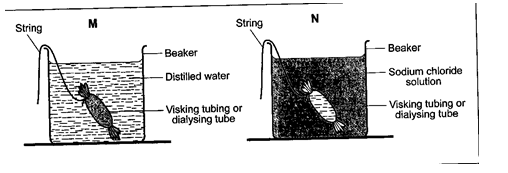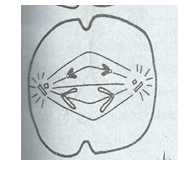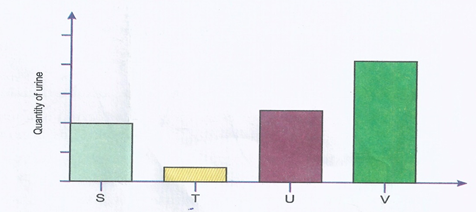INSTRUCTIONS TO CANDIDATE.
- Answer all questions in the spaces provided after each
- Give a reason for the following precautions during collection and observation of the specimen.
- Returning live specimen to their natural habitat after study. (1mk)
- Highly mobile animals should be immobilized during the study. (1mk)
-
- What is apical dominance ?(1mk)
- State 3 ways of breaking seed dormancy. (3mks)
-
- Name the chemical reagents used to test for protein (2mks)
- State the main function of co-factors in enzyme controlled reaction.(1mk)
-
- What is vaccination? (1mk)
- Explain the role of vaccination in providing immunity (2mks)
- Explain the biological significance of emulsification process in duodenum (2mks)
-
- Explain why there is less energy production in anaerobic respiration in living organism. (2mks)
- Define the following terms as used in respiration
- Oxygen debt (1mk)
- Respiration Quotient (1mk)
- The diagram below illustrates an experiment carried out by form one students.
- Explain what happens in set up Mat the end of experiment. (3mks)
- Explain how the following factors affect the rate of the process being investigated above in a living organism.
- Temperature above 1000 (1mk)
- A thin membrane (1mk)
-
- What is pollution ? (1mk)
- Distinguish between Global warming and green house effects. (2mks)
-
- Outline two beliefs held by the proponents of theory of special creation. (2mks)
- Outline structural difference between man and apes with respect to the following structures. (2mks)
Structure
Man
Ape
i)Pelvis
ii)Incisor
- State two importance of studying fossils records as evidence of organic evolution (2mks)
- Name the
- Salivary gland located beneath the tongue (1mk)
- Hormone that stimulate gall bladder to release the bile juice. (1mk)
- The diagram bellow illustrates a physiological process in a living organism
-
- Name the process shown above. (1mk)
- State the importance of the process named above in fish. (1mk)
- Name two parts of human being where the above process occurs (2mks)
-
-
- Name the polysaccharide that make up the exoskeleton in phylum Arthropoda (1mk)
- Name three external characteristics of animals that enable them to be classified as class Mammalia . (3mks)
- The diagram below shows a stage of cell division in a living organism
-
- Name the type of cell division shown. (1mk)
- Name the stage of cell division in a(a) (i) above. (1mk)
- Giving a reason for your answer name the Kingdom from which the cell was obtained.
- State any two importance of mitosis in a living organism. (2mks)
-
-
- State the differences in the composition of blood in the umbilical artery and umbilical vein (3mks)
- State two functions of the placenta (2mks)
- Explain how the following structural factors affects the rate of transpiration
- Hairy leaves. (2mks)
- Glossy leaf surface (2mks)
-
- What is non disjunction? (1mk)
- Outline three advantages of polyploidy to plants. (3mks)
-
- What is homeostasis? (1mk)
- The quantity of urine passed per in four mammals of the same species, I their natural habitats was S,T,U and V. the results were as shown in the figure below.
Which animal is likely to be living in a desert? Explain the reasons for your answer. -
- State the cause of liver cirrhosis (1mk)
- Outline any two symptoms of liver cirrhosis (2mks)
- Distinguish between Growth and Development (2mks)
-
- Outline any three functional differences between light microscope and electron microscope (3mks)
Light microscope
Electron microscope
- State three functions of golgi apparatus (3mks)
- Outline any three functional differences between light microscope and electron microscope (3mks)
-
- Name the causative agents of the following diseases (2 marks)
- Typhoid
- Whooping cough
- Explain why cigarette smoking can cause lung cancer (2mks)
- Name the causative agents of the following diseases (2 marks)

MARKING SCHEME
-
- To maintain ecological balance
- To allow for observation
-
- This is the suppression /inhibition of lateral buds sprouting by the apical bud due to higher auxin concentration of auxin at the apical bud (AWTTE)
- Some seeds are exposed to very cold temperature ; for a maximum period required to germinate; and stimulate higher temperature break their dormancy.
-
- Copper (II) sulphate ; and sodium hydroxide; (Rj CuSO4/NaOH)
- Activate enzyme;
-
- Vaccination is the introduction of weakenal/kicked pathogens into an organism to stimulate the production of antibiotics.
- -stimulation of production of antibodies against specific pathogen;
-Boosts immunity by vaccination at intervals.
- Breakdown of fats/ oils into small droplets; to increase surface are; for lipase; enzyme; to act on it.
-
- -Due to incomplete breakdown of food material.
-Some energy is locked up in the intermediate compound. -
- The extra amount of oxygen required to completely breakdown lactic acid that accumulate during aerobic respiration to water, carbon(IV) oxide and energy.
- The ratio of volume of carbon(IV) oxide produced to volume of oxygen consumed during respiration
- -Due to incomplete breakdown of food material.
-
- Visking tubing will be turgid; since it will gain; water by osmosis; from the beaker.
-
- Cell membrane is destroyed hence no osmosis.
- Faster movement of water molecules across the semi-permeable membrane accelerating osmosis.; (AWTTE)
-
- Release of substance / form of energy into the environment by human activities in such quantities whose effects are either harmful/ unpleasant to human / living organisms; (AWTTE)
- -Global warming – increase of global temperature due to excessive increase / accumulation n of carbon(IV) oxide / Nitrogen oxide /methane /CFCS in the atmosphere. (AWTTE)
-Green house effect- the formation of a thick layer of CO2 that surrounds the upper layer of the earth atmosphere trapping heat and prevent it from radiating out and getting lost in the space / preventing excessive cooling of the earth.
-
- -life was brought into existence by a supreme being.
-Life forms were created in a perfect form and have remained unchanged over time.
-The knowledge is based on faith and cannot be disputed. -
Structure
Man
Ape
Pelvis
Broked and flattened
Narrow and elongated
Incisor
Small
Large
- -Give direct evidence of the type of animal / plant that existed at a certain geological age.
-Show gradient increase in complexity of organism over time.
-Show almost complete evolution history of the development of certain orgaism / man/ horse.(Any two )
- -life was brought into existence by a supreme being.
-
- Sablingual salivary glands;
- Chelecysto kinin;
-
-
- Counter current flow;
- Maintain sleep concentration gradient across the respiratory surface for maximum gaseous exchange.;
- loop of henle; testes;
-
-
- Chitin;
- -Presence of mammsary glands;
- fur / hair on the body
- external ear/ two pinnae;
-
-
- Meiosis;
- Anaphase II;
- Kigdom ; Animalia
Reason- because of presence of - Basis of a sexual reproduction ensured that the chromosomal constitution/ genetic constitution of the offspring is the same as the parents;
-
-
- -Conducts motor impulse from the brain to the muscles;
- Act as a center of reflex actia;
- coordinates various nerve impulse from the body to the brain - – allow for the transmission of impulse from one neurone to the adjacent neurone.
- Ensures that impulse are transmitted from one neurone to the adjacent neurone in one direction only/ Allow for unidirectional impulse transmission to the adjacent neurone;
- Filters out weak impulse;
- plays important role in memory and learning.
- -Conducts motor impulse from the brain to the muscles;
-
- – To trap still moisture on the surface of the leaves thus reducing transpiration.
- Reflects the strong light rays/ reflects light landing on the leaf surface and so reduce internal heating and stomatal opening hence reducing the rate of transpiration;
-
- Failure of homologous chromosomes to segregate during meiosis; / failure of sister chromosomes to separate in anaphase II/ failure of homologous chromosomes to separate in anaphase I;
- – Results in the increased yields
- leads to resistance to drought
- leads to resistance to pests
- leads to resistance to diseases;
-
- Process of maintaining a constant internal environment of a living organism;
- T – produces least quantity of urine due to highest rate of reabsorption;
-
- Attack by either bacteria or virus and liver parasites.
- –Body weakness
-Loss of weight
-Poor appetite
-Pan in the upper right quarter of the abdomen
-Occasional vomiting of bloody materials;
- Growth is irreversible increase in size / mass while development refers to the irreversible change in the complexity of the structure of living things.
-
Light microscope
Electron microscope
Uses light to illuminate the specimen
Uses beam of electrons to illuminate specimen
Has low resolving power
Has high resolving power
Has low magnification power
Has high magnification power
Specimen under view can be living or dead
Specimen under vie2w is dead.
-
- inter –vertebral disc
- -Absorbs the shock
- Reduce the friction between the adjacent vertebrae
- Brings about flexibility of vertebrae to bring about movement.;
Download BIOLOGY PAPER 1 - KCSE 2019 MASENO MOCK EXAMINATION (WITH MARKING SCHEME).
Tap Here to Download for 50/-
Get on WhatsApp for 50/-
Why download?
- ✔ To read offline at any time.
- ✔ To Print at your convenience
- ✔ Share Easily with Friends / Students





